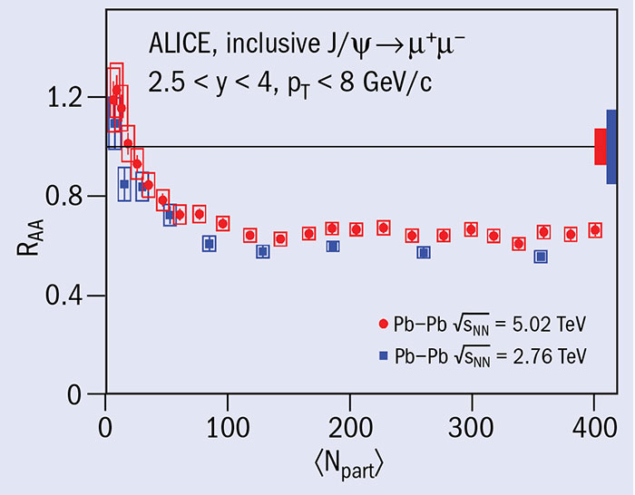The ALICE Collaboration has measured with improved precision the production of J/ψ mesons in collisions of lead nuclei at the highest LHC energy, confirming the role of the “regeneration mechanism” in J/ψ production.
J/ψ mesons are bound states of a charm (c) and anticharm (c) quark and they are particularly sensitive probes of the quark–gluon plasma (QGP) formed in high-energy heavy-ion collisions. The production of J/ψ mesons is suppressed in the QGP by the screening of the cc binding, which is generated by the large surrounding colour-charge density. Such suppression was observed at RHIC in the US in AuAu collisions at a collision energy of 0.2 TeV and at the CERN SPS in PbPb collisions at 17.6 GeV. Using data from LHC Run 1, ALICE also measured a suppression in PbPb collisions at 2.76 TeV. However, the value was smaller than that measured at lower collision energy (see CERN Courier March 2012 p14), which was found to be consistent with a new mechanism of J/ψ production in the QGP: regeneration by recombination of deconfined charm and anticharm quarks.
The J/ψ suppression is quantified by the nuclear modification factor (RAA), which is defined as the ratio of the yield in PbPb to that in an equivalent number of pp collisions. The J/ψ RAA measured by ALICE as a function of the average number of nucleons participating in the collision in PbPb collisions at 5.02 TeV is compared to the value at 2.76 TeV. The larger the number of participating nucleons, the more head-on and violent the collisions.

A clear decreasing trend of the RAA with increasing participating nucleons is observed for peripheral collisions, followed by a constant evolution for more central collisions (see figure). Thanks to the increased integrated luminosity delivered by the LHC, the higher collision energy and improved detection techniques, the accuracy of the new measurement is highly improved and confirms ALICE’s earlier observation. In short, at LHC energies, a J/ψ regeneration mechanism competes with the J/ψ suppression mechanism, both of which are due to the formation of the QGP.
The improved accuracy of the RAA measurement at 5.02 TeV imposes strong constraints on theoretical calculations, the uncertainties of which are now significantly larger than the experimental ones. The additional data expected to be accumulated during LHC Run 2 will further constrain the models through more differential measurements, including the J/ψ elliptic flow.








